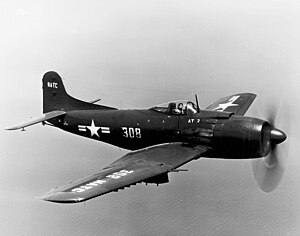Martin XBTM-1 Mauler
| AM Mauler | |
|---|---|
 |
|
| An AM-1 of the U.S. Naval Test Center | |
| Role | Attack aircraft |
| National origin | United States |
| Manufacturer | Glenn L. Martin Company |
| First flight | 26 August 1944 |
| Introduction | March 1948 |
| Retired | 1953 |
| Primary user | United States Navy |
| Number built | 151 |
The Martin AM Mauler (originally XBTM) was a single-seat shipboard attack aircraft built for the United States Navy. Designed during World War II, the Mauler encountered development delays and did not enter service until 1948 in small numbers. The aircraft proved troublesome and remained in frontline service only until 1950, when the Navy switched to the smaller and simpler Douglas AD Skyraider. Maulers remained in reserve squadrons until 1953. A few were built as AM-1Q electronic-warfare aircraft with an additional crewman in the fuselage.
In the 1930s and early 1940s, the Navy divided carrier-borne bombers into two types: the torpedo bomber and the dive bomber, each with crews of two or three men. Wartime experience showed that pilots could aim bombs and torpedoes without assistance from other crewmembers as well as navigate with the aid of radio beacons and the development of more powerful engines meant that faster aircraft no longer needed a rear gunner for self-defense. Furthermore, the consolidation of the two types of bombers greatly increased the flexibility of a carrier's air group and allowed the number of fighters in an air group to be increased.
In 1943, the US Navy invited proposals for a new multi-purpose bomber and selected four designs in September: the Curtiss XBTC, Douglas XBT2D Skyraider, Kaiser-Fleetwings BTK and the Martin XBTM. Martin was tasked to provide a backup to the Curtiss design which had been selected as a replacement to the Curtiss SB2C Helldiver. Due to the US Navy's concern that the Curtiss design was overly complex and that the company's record was particularly poor during the Helldiver's development, Martin was instructed to create an "unexperimental" design that would be a reliable platform for the Pratt & Whitney R-4360 Wasp Major radial engine that powered both aircraft. Two prototypes were ordered from Martin on 31 May 1944 with the internal designation of Model 210.
...
Wikipedia
